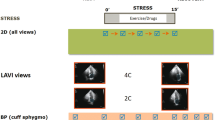Abstract
Stress induced changes in left ventricular ejection fraction are widely used in the detection and assessment of coronary artery disease. This study demonstrates that right ventricular dysfunction may also occur, and assesses its significance in terms of coronary artery anatomy. This study involved 14 normal subjects and 26 with coronary artery disease investigated by equilibrium radionuclide ventriculography, at rest and during maximal dynamic exercise. Mean normal resting right ventricular ejection fraction (RVEF) was 0.40 (SD 0.118), and all normal subjects increased RVEF with stress (mean ΔRVEF+0.13 SD 0.099). Mean Δ RVEF in the subjects with coronary artery disease was significantly lower at 0.00 (SD 0.080), but there was overlap between the two groups. The largest falls in RVEF were seen if the right coronary artery was occluded without retrograde filling. In this subgroup with the most severely compromised right ventricular perfusion (nine subjects), RVEF always fell with stress, and mean Δ RVEF was-0.08 (SD 0.050). There was no significant correlation between Δ LVEF and Δ RVEF, implying that the right ventricular dysfunction was due to right ventricular ischaemia, rather than secondary to left ventricular dysfunction. Stress induced right ventricular ischaemia can therefore be detected readily by radionuclide ventriculography.
Similar content being viewed by others
References
Berger HJ, Johnstone DE, Sands MJ, Gottschalk A, Zaret BL (1978) First-pass radionuclide assessment of right ventricular performance during exercise in coronary artery disease: Relationship to left ventricular reserve and right coronary stenosis. Circulation 57 and 58 Supp II:II-132 (abstr)
Borer JS, Bacharach SL, Green MV, Kent KM, Epstein SE, Johnston GS (1977) Real-time radionuclide cineangiography in the noninvasive evaluation of global and regional left ventricular function at rest and during exercise in patients with coronary artery disease. N Engl J Med 296:839–844
Brown KA, Okada RD, Boucher CA, Strauss W, Pohost GM (1984) Right ventricular ejection fraction response to exercise in patients with coronary artery disease: influence of both right coronary artery disease and exercise induced changes in right ventricular overload. J Am Coll Cardiol 3:895–901
Cohn JN, Guiha NH, Broder MI, Limas CJ (1974) Right ventricular infarction: Clinical and haemodynamic features. Am J Cardiol 33:209–214
Farrer-Brown G (1968) Vascular pattern of myocardium of right ventricle of human heart. Br Heart J 30:679–686
Freeman MR, Berman DS, Staniloff H, Elkayam U, Maddahi J, Swan HJC, Forrester JS (1981) Comparison of upright and supine bicycle exercise in the detection and evaluation of extent of coronary artery disease by equilibrium radionuclide ventriculography. Am Heart J 102:182–189
Geffers H, Adam WE, Bitter F, Siegel H, Kampman H (1977) Data processing and functional imaging in radionuclide ventriculography. In: Brill AB, Price RR (eds) Information processing in medical imaging. Proceedings of the 5th international conference. Biomedial Computing Technology Information Centre, Nashville, pp 322–332
Gentzler RD, Briselli MF, Gault JH (1974) Angiographic estimation of right ventricular volume in man. Circulation 50:324–330
Goris ML, Briandet PA, Huffer E (1979) Automation and operator independant data processing of cardiac and pulmonary functions: role, methods and results. In: Di Paolo R, Kahn E (eds) Information processing in medical imaging. Proceedings of the 6th international conference. INSERM, Paris 88:427–448
Johnson LL, McCarthy DM, Sciacca RR, Cannon PJ (1979) Right ventricular ejection fraction during exercise in patients with coronary artery disease. Circulation 60:1284
Longmore DB, Klipstein RH, Underwood SR, Firmin DN, Homsfield GN, Watanabe M, Bland C, Fox K, Poole-Wilson PA, Rees RSO, Denison D, McNeilly AM (1985) The dimensional accuracy of magnetic resonance in studies of the heart. Lancet 1:1360–1362
Maddahi J, Berman DS, Matsuoka DT, Waxman AD, Stankens KE, Forrester JS, Swan HJC (1979) A new technique for assessing right ventricular ejection fraction using rapid multiplegated equilibrium cardiac blood pool scintigraphy. Circulation 60:581–589
Maddahi J, Berman DS, Matsuoko DT, Waxman AT, Forrester JS, Swan HJC (1980) Right ventricular ejection fraction during exercise in normal subjects and in coronary artery disease patients: assessment by multiple-gated equilibrium scintigraphy. Circulation 62:133–140
Marmor A, Geltman EM, Biello DR, Sobel BE, Siegel BA, Roberts R (1981) Functional response of the right ventricle to myocardial infarction: Dependence on the site of left ventricular infarction. Circulation 64:1005–1011
Rigo P, Murray M, Taylor D, Weisfeldt ML, Kelly DT, Strauss HW, Pitt B (1975) Right ventricular dysfunction detected by gated scintiphotography in patients with acute inferior myocardial infarction. Circulation 52:268–274
Sharpe DN, Botvinick EH, Shames DM, Schiller NB, Massie BM, Chatterjee K, Parxley WW (1977) The noninvasive diagnosis of right ventricular infarction. Circulation 57:483–490
Slutsky R, Hooper W, Gerber K, Battler A, Froelicher V, Ashburn W, Karliner J (1980) Assessment of right ventricular function at rest and during exercise in patients with coronary heart disease: A new approach using equilibrium radionuclide angiography. Am J Cardiol 45:63–71
Underwood SR, Walton S, Laming PJ, Ell PJ, Emanuel RW, Swanton RH (1983) Differential sensitivity of Fourier phase and amplitude images in the detection of anterior and inferior left ventricular wall motion. Nucl Med Commun 4:135 (abstr)
Wade WG (1959) The pathogenesis of infarction of the right ventricle. Br Heart J 21:545–554
Walton S (1983) Noninvasive evaluation of right ventricular function. J R Soc Med 76:337–9
Walton S, Rowlands DJ, Shields RA, Testa HJ (1979) Study of right ventricular function in ischaemic heart disease using radionuclide angiocardiography. Intensive Care Med 5:121–126
Walton S, Jarritt PH, Ell PJ (1980) Improved reproducibility of ejection fraction estimation utilising the phase image. Use of the technique to determine the heart's response to isometric exercise. In: Nuklearmedizin. Schattauer Verlag, Stuttgart, pp 220–224
Xue QF, Macnee W, Flenley DC, Hannan WJ, Adie CJ, Muir AL (1983) Can right ventricular performance be assessed by equilibrium radionuclide ventriculography? Thorax 38:486–493
Author information
Authors and Affiliations
Rights and permissions
About this article
Cite this article
Underwood, S.R., Costa, D.C., Walton, S. et al. Stress induced right ventricular dysfunction: An indication of reversible right ventricular ischaemia. Eur J Nucl Med 12, 529–532 (1987). https://doi.org/10.1007/BF00296091
Received:
Accepted:
Issue Date:
DOI: https://doi.org/10.1007/BF00296091



